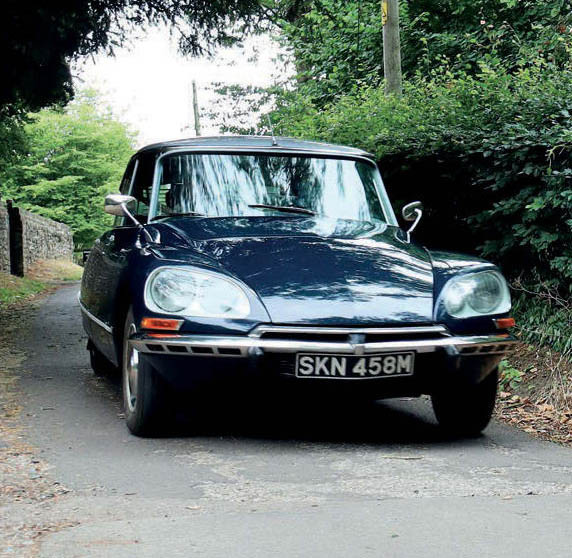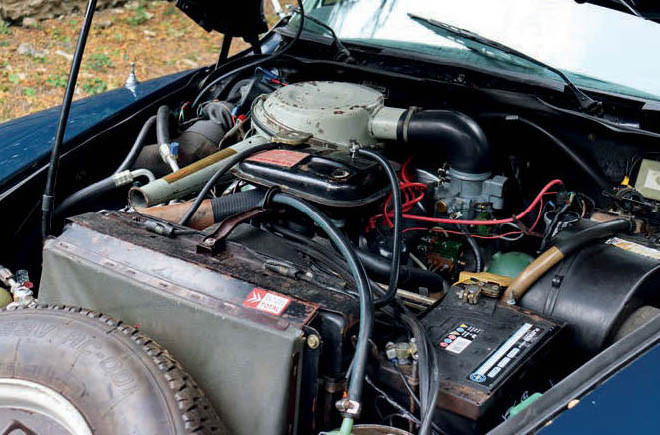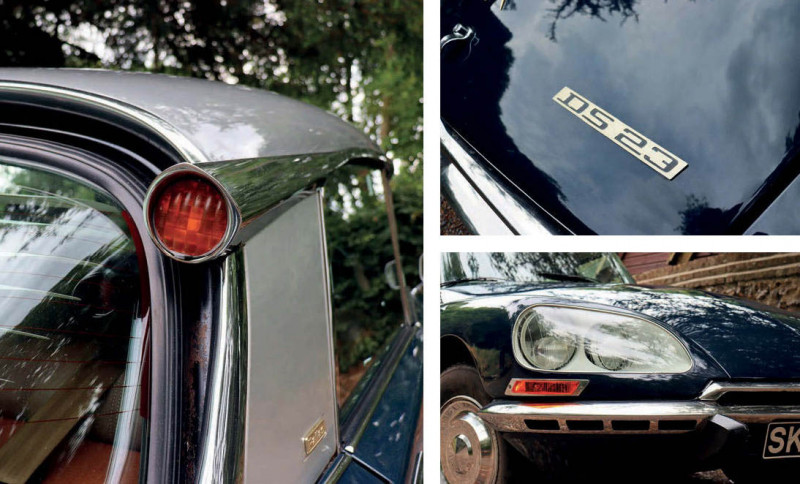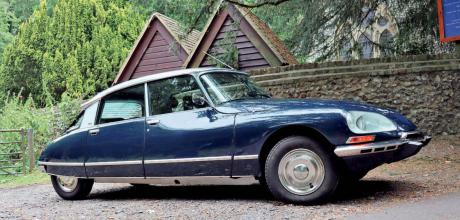1973 Citroën DS23 Pallas Semi-Automatic
The Citroën DS seemed like a spaceship when it was launched nearly sevendecades ago – how does it stack up today?
Words and photography: Joe Miller
DOMESTIC GODDESS
Joe Miller meets one of his heroes as he takes to the road in a late-model Citroën DS.
The French had another revolution in 1955, this time in motoring. The Citroën DS was the culmination of 18 years of secret development and would replace the Traction Avant. The Traction, although popular and technically impressive, looked the 1930s design it was and what was once standout had become familiar. In an effort to create a striking all-new look for its replacement, Citroën put two people in charge of design – Italian sculptor and designer Flaminio Bertoni (not to be confused with Bertone) and French aeronautical engineer André Lefèbvre. Bertoni wanted a beautiful piece of design, whereas Lefèbvre wanted as aerodynamic a shape as possible. Ultimately, we got both.

View the DS side-on or from the rear and you notice its teardrop shape, tapering down to a short tail and partly enclosing the rear wheels, all in an effort to cut through the air effortlessly compared to slab-fronted contemporaries such as the Rover P4. But delve deeper and you’ll find endless gorgeous styling cues, like the rear indicators being housed in chrome flutes that run along the roof, the art-deco rear lights and – after the Robert-Opron-penned 1967 facelift – enclosed headlights that seamlessly integrate into curvaceous front wings.

You might’ve noticed I’m gushing a bit, so I should give full disclosure at this stage: the DS is not only my dream car, but in my eyes the greatest car ever made (more on that later) and possibly the most beautiful. Step back from the details to admire the DS in its entirety and you’ll see my point – this car is a masterpiece from every angle, managing to look stylish but not attention-seeking, classy but far from anonymous. Think about how futuristic it must’ve looked in the 1950s compared to conventional three-box saloons of the day; indeed, you can spot a DS in the Back to the Future II movie, only lightly altered to play the role of a taxi from the year 2015. That’s 26 years on from the film’s release and 60 years from the car’s launch.
“BERTONI WANTED A BEAUTIFUL PIECE OF DESIGN, WHEREAS LEFÈBVRE WANTED AS AERODYNAMIC A SHAPE AS POSSIBLE. ULTIMATELY, WE GOT BOTH."

Citroën were so impressed with the final product that they gave the new car a name befitting of its looks; DS is pronounced “day-ess” in French and translates as ‘Goddess’. When the car was unveiled at the 1955 Paris Motor Show, crowds flocked to the spaceship-esque Citroën and over 700 customers placed orders in the first 15 minutes. By the end of day one, the DS had attracted 20,000 orders, a launch day record that remained unbroken for over 60 years. That success was partly down to the DS also being a technological tour de force. The car was built on base unit construction, whereby the chassis is the stress-bearing skeleton, with the panels and doors – many of which were made of lightweight aluminium or fibreglass – simply hung on it to keep the bulk of the weight low down. The construction of the DS also featured pioneering safety features, including crumple zones and an engine designed to submarine underneath the occupants in the event of a frontal collision. Citroën’s tie-up with Michelin meant the DS wore modern radial tyres from launch, and it would also become the first mass-produced car with disc brakes, mounted inboard to reduce unsprung weight.

The 1967 facelift’s enclosed headlights swivelled with the wheels, allowing drivers to see around corners at night and the driving itself was made easier still with power steering – still rare on anything beneath a Rolls-Royce – and a clutchless semiautomatic gearbox. The latter two were made possible by Citroën’s phenomenal and deceptively simple Hydropneumatic suspension system. In essence, the system is powered by an engine-driven pump, pressurising hydraulic fluid around the car for the power brakes and steering. Rather than springs and shock absorbers, the four corners of the car are suspended by metal spheres of nitrogen, which when combined with the pressurised hydraulic fluid in the lower half of the sphere, allow variable resistance and damping, effectively causing the suspension arms to float. The net result is that all four wheels are permanently in contact with the road and the system is self-levelling, even after an enthusiastic trip to the fromagerie.

So, how does that technology translate to the road? The power steering is an oddity – as heavy when parking as any non-PAS car, but it lightens up dramatically once you’re moving to the point of being fingertip driveable. One for feedback and feel it is not, but this isn’t that sort of car. The hydraulically-powered brakes are similarly unusual, with the traditional swing-away brake pedal replaced by a small mushroom on the floor. This sounds unusual, but it makes sense once you press it, as the brakes in a DS are extremely effective and respond instantly. They often intimidate novices, as you have to relearn how little brake pressure to use, but it’s an easy learning curve. The ride is the standout – the DS floats over bumps and potholes without so much as a shimmy over all but the biggest potholes. We’ve all heard the magic carpet cliché, but drive a DS and you understand it – this car simply glides along in a manner Rolls-Royce couldn’t match. No wonder Rolls licenced the suspension technology for the Silver Shadow…
In all but the most powerful DS23 seen here, progress is leisurely – the engine is neither tuneful nor powerful, and not particularly efficient. The powerplant was dated when the DS was new and it feels it, so it’s little wonder these cars are often cited as the perfect candidate for electrification. That said, the bigger engines are torquey enough to pull you along at a reasonable pace and motorway cruising is well within their repertoire, making European tours a joy. Combine the light steering, powerful brakes and floaty ride and you’ve got what might be the most calming driving experience in the world. If you suffer with a high heart rate, get yourself a DS – there’s really no comfier, more relaxing way to travel.
The DS wasn’t cheap though. At £1700 when launched, it was over £500 pricier than the Rover P4, not to mention 65 per cent more expensive than the Traction Avant it replaced. But those beguiling looks, the plethora of advanced technology and the introduction of the cheaper, more basic ID model in 1957 meant over its 20-year life, some 1.45m units were sold. The DS continued to impress long after launch, with its plush suspension making it a remarkably capable rally car; capable enough to win the Monte Carlo Rally and 1000 Lakes Rally. What’s more, the suspension’s self-levelling characteristic allowing it to drive on less than four wheels meant President Charles de Gaulle’s DS was able to escape his would-be assassins when they shot two tyres out in 1962. De Gaulle said the DS saved his life and refused to travel in anything other than hydraulic Citroëns.
Few cars have ever done so much to advance the progression of the automobile and almost every car made since owes something to the Citroën DS. What’s more, the DS looks as gorgeous today as it ever has, fitting in everywhere from film premiere to farmyard.
Consider what it achieved, what it represented and how successful and iconic it became almost immediately, you can see why I’m not alone in proclaiming the Citroën DS the greatest car ever made.
A great ride and light steering make the DS a joy to drive. The engines were dated even when the DS was new, but still make for relaxed cruising.
SPECIFICATIONS
- MODEL Citroën DS23 Pallas Semi-Automatic
- ENGINE 2347cc
- MAX POWER 115bhp at 5500rpm
- MAX TORQUE 135lb.ft at 3500rpm
- 0-60 MPH 11.6secs
- MAX SPEED 111mph
- ECONOMY 29.1mpg
- LENGTH 4.9m
- WIDTH 1.8m
- KERB WEIGHT 1317kg
The DS is brimming with brilliantly quirky details and styling cues.


